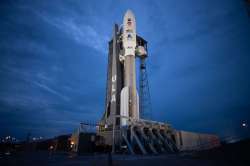Countdown begins for Mars Perseverance launch — Here’s your last minute crash course
NASA is all decked up and ready to launch the car-sized Mars rover named Perseverance along with a robotic helicopter named Ingenuity. The two mechanical devices will be traveling to Mars in search of signs of past microbial life and examine the Martian climate and geology in the area which is being called — Jezero crater. If everything goes as planned, the robots will land on the surface of Mars on February 18, 2021.

NASA is all decked up and ready to launch the car-sized Mars rover named Perseverance along with a robotic helicopter named Ingenuity. The two mechanical devices will be traveling to Mars in search of signs of past microbial life and examine the Martian climate and geology in the area which is being called — Jezero crater. If everything goes as planned, the robots will land on the surface of Mars on February 18, 2021.
The travel time between the Earth and Marsh would be about 6 and a half months. The mission will be historic in more ways than one.
Quick facts about the mission
- Mission Name: Mars 2020
- Rover Name: Perseverance
- Main Job: The Perseverance rover will seek signs of ancient life and collect rock and soil samples for possible return to Earth.
- Launch Window: July 30 - Aug. 15, 2020
- Launch Location: Cape Canaveral Air Force Station, Florida
- Landing: Feb. 18, 2021
- Landing Site: Jezero Crater, Mars
- Mission Duration: At least one Mars year (about 687 Earth days)
- Tech Demo: The Mars Helicopter is a technology demonstration, hitching a ride on the Perseverance rover.
First Earthly Aircraft to fly on another planet.
As soon as the landing procedure completes, the Ingenuity helicopter will be put in action, this will make the aerial device the first earthly aircraft to fly on another planet.
Mission Timeline
- Launch in July-August 2020 from Cape Canaveral Air Force Station, Florida
- Launching on a ULA Atlas 541 procured under NASA’s Launch Services Program
- Land on Mars on February 18, 2021 at the site of an ancient river delta in a lake that once filled Jezero Crater
- Spend at least one Mars year (two Earth years) exploring the landing site region
Key Objectives
- Explore a geologically diverse landing site
- Assess ancient habitability
- Seek signs of ancient life, particularly in special rocks known to preserve signs of life over time
- Gather rock and soil samples that could be returned to Earth by a future NASA mission
- Demonstrate technology for future robotic and human exploration
The launch will take place at about 1720 hours IST. The countdown as begun and as we write the story, at 09:00 am, there are about 8 hours and 20 minutes to go until the launch. You can follow the live NASA countdown here.